|
|
|
OULMONT, Charles ; PASTEUR, Louis
Pensée de Pasteur
1 vol. in-12 br., ISTRA, Strasbourg - Paris, 1970, 75 pp.
Referencia librero : 45658
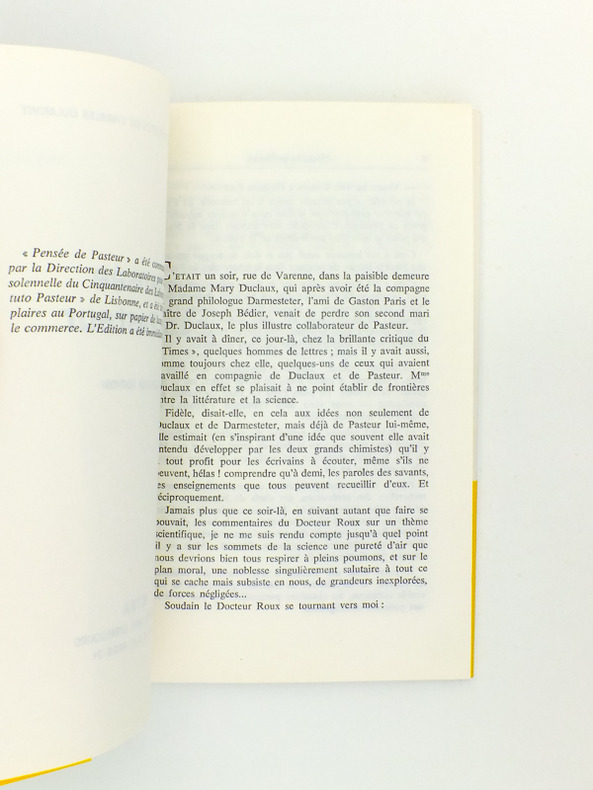
|
|
|
Rhône-Poulenc
La fertilisation des sols et la protection des cultures ( col. La chimie dans le monde moderne )
1 chemise petit in-8 avec 101 ff., ill. noir et blanc, Rhône-Poulenc, s.d. (circa 1975)
Referencia librero : 46064

|
|
|
PIOLA ; FALIERES ; BOITEAU ; DUPUY
Association viticole de l'arrondissement de Libourne pour l'Etude du Phylloxera et des moyens de le combattre. Premier et Deuxième Fascicule
2 brochure in-8, Imprimerie C. Dessiaux et E. Contant puis Imprimerie de l'intérêt Public, Libourne, 1875, 32 et 34 pp.
Referencia librero : 47103
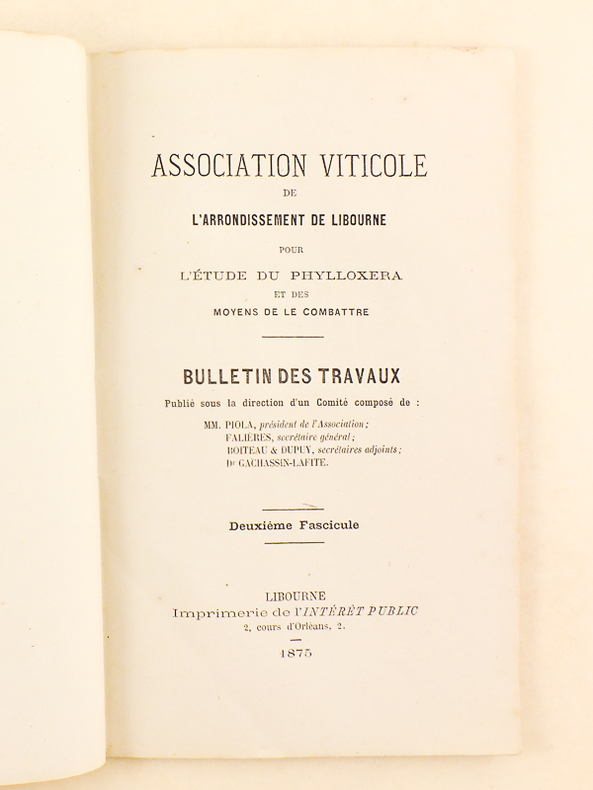
|
|
|
Pechiney Progil
Aide-mémoire de la défense des cultures ( par Pechiney Progil )
1 vol. in-4 br. , ill. noir et blanc, Pechiney Progil, s.d. (1955), 63 pp.
Referencia librero : 47225
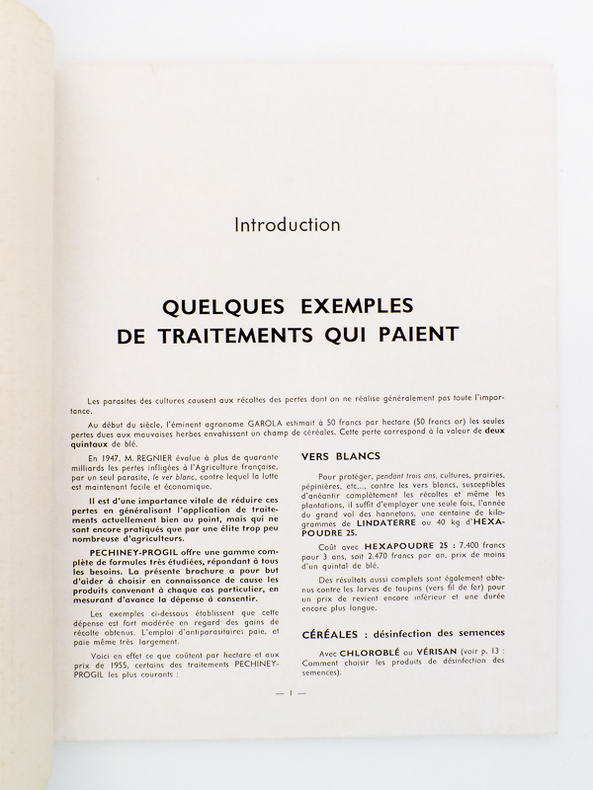
|
|
|
BOULANGER, Henri
Essais du Cuir dans ses Applications Industrielles [ Edition originale - Livre dédicacé par l'auteur ]
1 vol. in-4 reliure plein chagrin brun, dos à 5 nerfs, Mémoires publiés par la Société d'Encouragement pour l'Industrie Nationale, Siège de la Société, Paris, 1907, 503 pp.
Referencia librero : 49133

|
|
|
Ecole Nationale d'Arts et Métiers d'Angers
Cours de Chimie , Ecole Nationale d'Arts et Métiers d'Angers ( 1899 )
1 vol. in-4 rel. pleine percaline noire, reproduct. mécan. de texte manuscrit, Ecole Nationale d'Arts et Métiers d'Angers, Angers, 1899, 624 pp.
Referencia librero : 49187

|
|
|
Collectif ; DIDEROT ; D'ALEMBERT
Chimie. [ Recueil de planches, sur les sciences, les arts libéraux et les arts mechaniques : avec leur explication ]
1 vol. in-folio br., s.l.n.d. [ Briasson, David, Le Breton et Durand, 1763 ], 4 pp. (tables), 1 planche double et 23 planches simples
Referencia librero : 50458
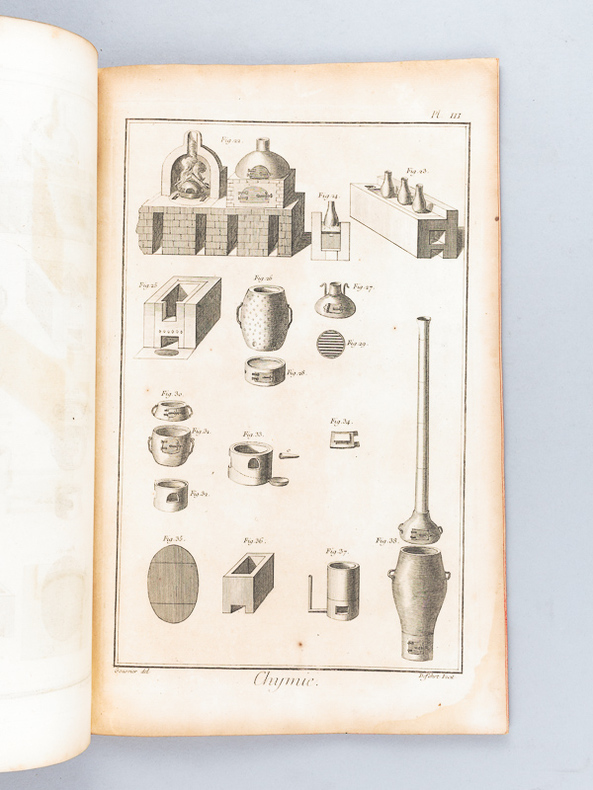
|
|
|
PRIGOGINE, Ilya Chargé de Cours à l'Université de Bruxelles
Etude thermodynamique des phénomènes irréversibles [ Edition originale ]
1 vol. in-8 br., Dunod, Paris, Editions Desoer, Liège, 1947, IX-143 pp.
Referencia librero : 50460

|
|
|
PORCHER-PIMPARD, Madame
Contribution à l'étude du pouvoir antiseptique des essences végétales. Thèse pour le Doctorat de l'Université (Mention Pharmacie) présentée et soutenue publiquement en Juillet 1942
1 vol. in-8 br., Université de Toulouse, Imprimerie B. Arnaud, Grasse, 1942, 98 pp.
Referencia librero : 51083
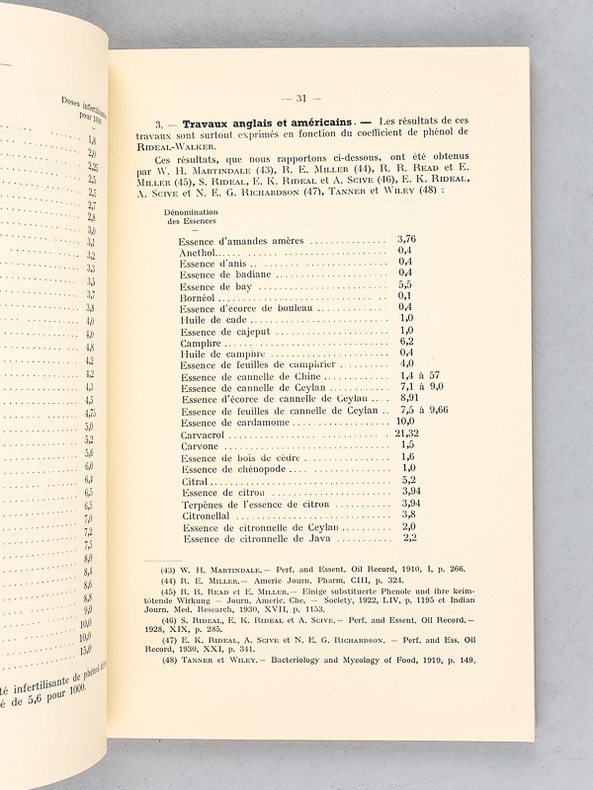
|
|
|
AZALOUX, Docteur André
L'OL 24 Ses indications thérapeutiques. Contribution à l'étude de la thérapeutique antiseptique par les essences végétales.
1 vol. in-8 br., Université de Toulouse, Imprimerie B. Arnaud, Grasse, 1943, 100 pp.
Referencia librero : 51084
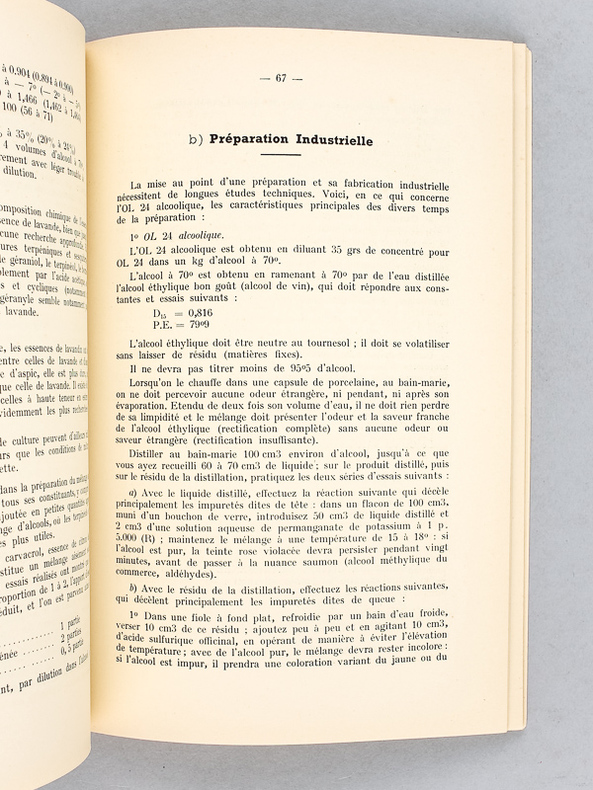
|
|
|
CAZAL, Roger
Contribution à l'étude de la l'activité pharmacodynamique de quelques essences de Labiacées.
1 vol. in-8 br., Université de Toulouse, Imprimerie B. Arnaud, Grasse, 1944, 172 pp.
Referencia librero : 51085

|
|
|
BALLAND, A.
La Chimie alimentaire dans l'Oeuvre de Parmentier [ Edition originale ]
1 vol. in-8 br., Librairie J.-B. Baillière et Fils, Paris, 1902, 448 pp.
Referencia librero : 51209

|
|
|
GUIBOURT, N.-J.-B.-G. [ GUIBOURT, Nicolas Jean-Baptiste Gaston 1790-1867 ]
Histoire abrégées des drogues simples, Tome Second [ 2 ]
1 vol. in-8 rel. demi-basane brune, toutes tr. marbrées, chez L. Colas - Méquignon-Marvis, chez l'Auteur, Pharmacien, à Paris, 1820, 454 pp. Ce tome débute à l'article 515, relatif aux Absinthes et s'achève sur la table de l'ensemble de l'ouvrage.
Referencia librero : 51906

|
|
|
Collectif ; LASSEUR, Prof. [ LASSEUR, Philippe 1882-1946 ]
Hommage au professeur Lasseur
Ex. num. (n° 158), 1 vol. in-8 br., portrait en fronstip., s.n., Nancy, 1934, 32 pp.
Referencia librero : 52173

|
|
|
ROCQUES, X.
Analyse des alcools & des Eaux-de-vie [ Edition originale ]
1 vol. in-12 reliure demi-basane verte, Encyclopédie Scientifique des Aide-Mémoire, Gauthier-Villars et Fils, G. Masson, Paris, s.d., 198 pp.
Referencia librero : 52400

|
|
|
CARLES, Dr. P.
Les Trépidations et les Vins. Les Vins retours de l'Inde. Vieillissement mécanique des vins et des Cognacs [ Edition originale ]
1 vol. grand in-8 reliure demi-basane verte, couverture conservée, Féret et Fils, Bordeaux, L. Mulo & Cie, Paris, 1909, 79 pp.
Referencia librero : 52402
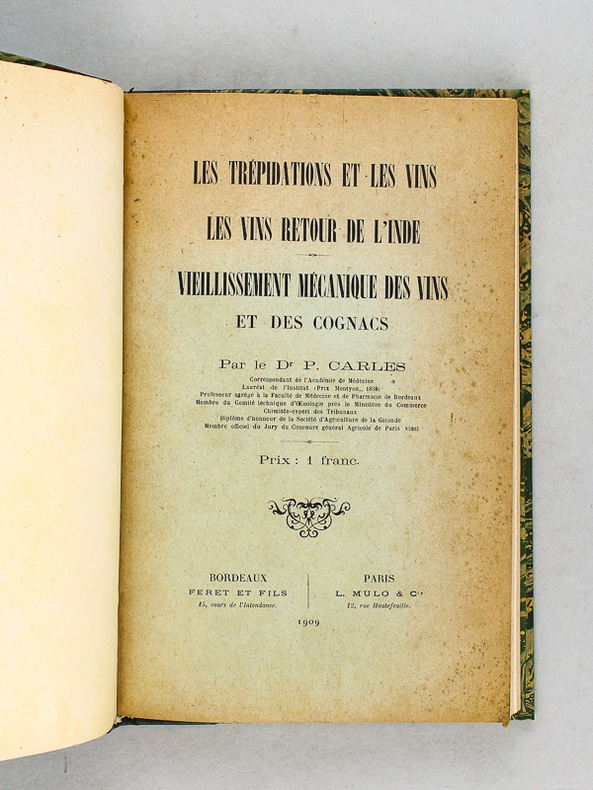
|
|
|
BAUDRIMONT, A.
La Vigne, l'Oïdium, le Vin. Trois leçons du Cours de Chimie Agricole. Suivies d'une notice sur la préparation des boissons artificielles. [ Edition originale ]
1 vol. in-12 reliure demi-basane verte, P. Chaumas, Bordeaux, 1862, 133 pp. et 1 f. n. ch.
Referencia librero : 52403

|
|
|
SEMPE, Raymond
Etude sur les Vins Exotiques. Production - Exportation [ Edition originale ] XIIe Exposition Générale de Bordeaux 1882 Universelle pour les Vins
1 vol. in-12 reliure demi-basane verte, Féret et Fils, Bordeaux, 1882, 2 ff., 195 pp. et 2 ff.
Referencia librero : 52404

|
|
|
SEMICHON, Lucien ; GAYON, Ulysse
Traité des Maladies des Vins. Description. Etude. Traitement [ Edition originale ]
Avec une Préface par U. Gayon, avec 13 planches hors texte et 116 figures dans le texte, 1 vol. in-8 reliure demi-percaline verte, Coulet et Fils, Montpellier, Masson et Cie, Paris, 1905, XIV-654 pp. ave 13 pl. hors texte
Referencia librero : 52409
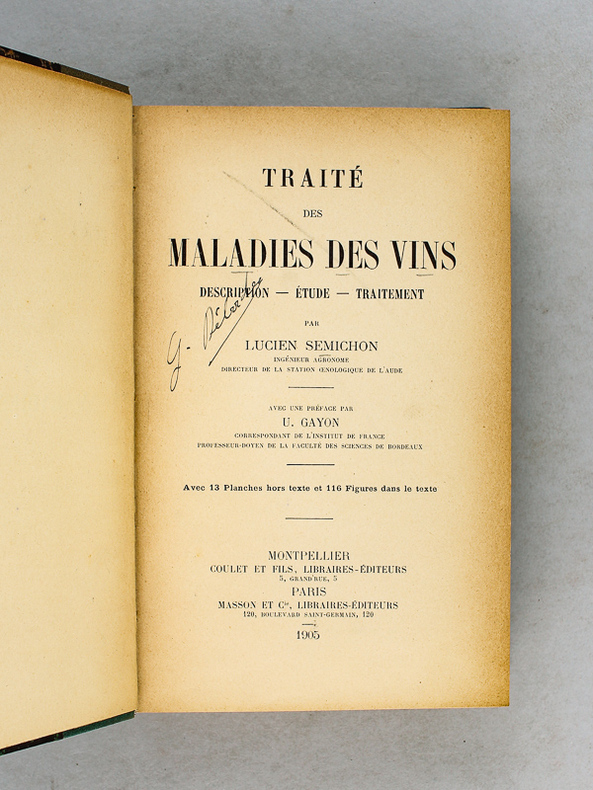
|
|
|
DENIGES, Georges
Leçons d'analyse qualitative sur les Eléments Métalloïdiques et leurs principaux dérivés. [ Edition originale - Livre dédicacé par l'auteur ]
1 vol. petit in-8 reliure demi-percaline verte, A. Maloine et Fils, Paris, 1920, 3 ff., 302 pp. et 1 f.
Referencia librero : 52410
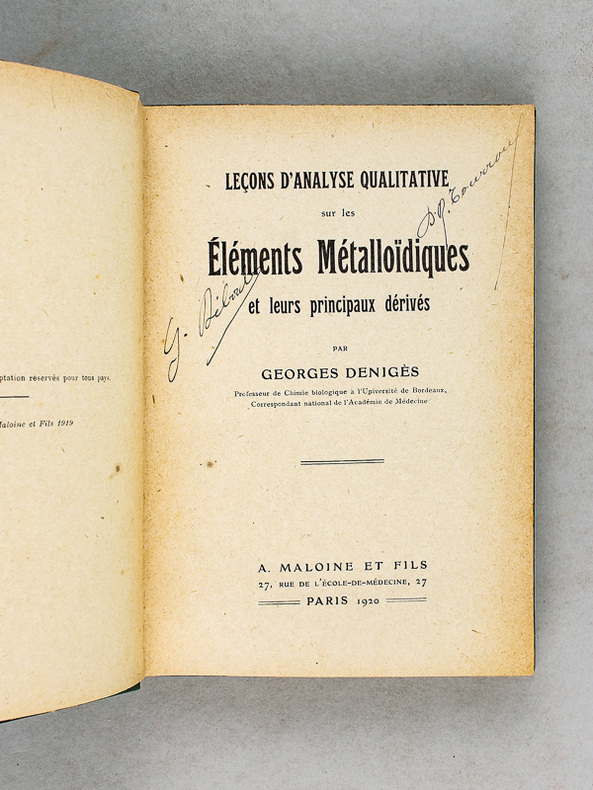
|
|
|
DUPONT, Georges
Cours de Chimie Industrielle (5 Tomes - Complet) Tome I : Généralités - Les combustibles ; II : Les industries minérales ; III : Métallurgie ; IV : Industries organiques ; V : Industries organiques (suite)
5 vol. in-8 reliure demi-basane verte, Gauthier-Villars, Paris, 1936, vi-184 ; 337 ; 357 ; 250 ; 279 pp.
Referencia librero : 52426
|
|
|
ROUGET, L.G.F.
Sus aux fraudeurs ! Connaissance des Falsifications des Substances alimentaires et des boissons. Moyens pratiques de reconnaître la fraude, à la portée de tout le monde [ Edition originale ]
1 vol. in-12 reliure demi-basane verte, Librairie Ve Gimet, Toulouse, 1884, 160 pp.
Referencia librero : 52497

|
|
|
MAUMENE, E.-J.
Comment s'obtient le Bon Vin. Manuel du Vinifacteur [ Edition originale ]
1 vol. in-8 reliure demi-percaline verte, Encyclopédie des Connaissances Pratiques, Tome III, Société d'Editions Scientifiques, Paris, 1894, 238 pp.
Referencia librero : 52499
|
|
|
JAULMES, Paul
Analyse des Vins
2e éd. revue, 1 vol. fort in-12 rel. demi-basane verte, Librairie Poulain, Montpellier, 1951, 574 pp.
Referencia librero : 52546
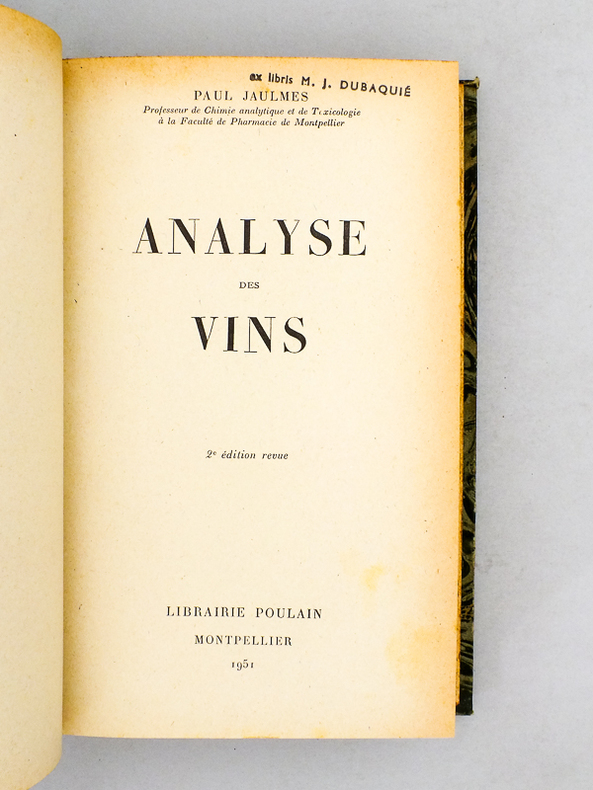
|
|
|
SANFOURCHE, A. [ SANFOURCHE, Adrien-André (1888-1956) ] ; BROGLIE, Maurice de (préf.)
Le contrôle analytique dans l'industrie chimique minérale [ exemplaire dédicacé par l'auteur ]
Envoi de l'auteur, 1 vol. in-12 rel. demi-basane verte, Masson et Cie éditeurs, Paris, 1936, 548 pp.
Referencia librero : 52547
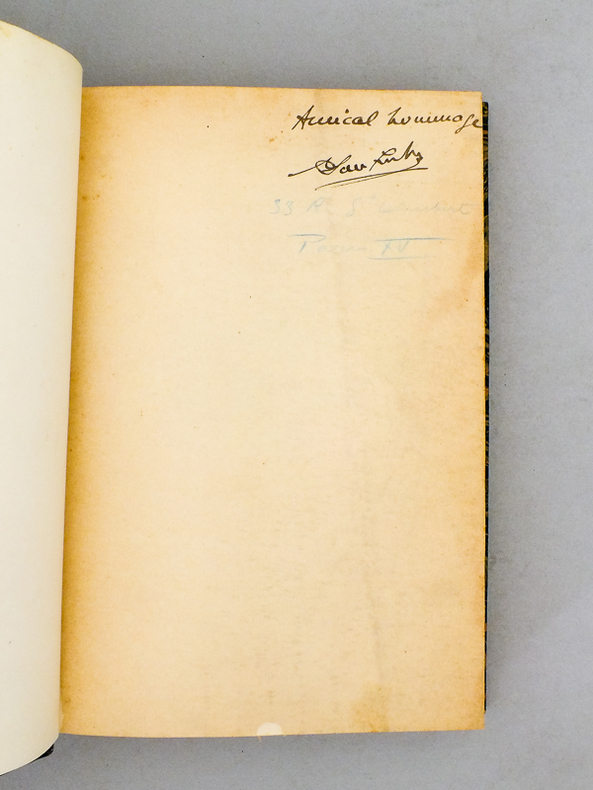
|
|
|
Polonovski, Michel ; Lespagnol, Albert ; DESGREZ, A. (préf.)
Chimie organique biologique - Introduction chimique à l''étude de la biologie générale
1 vol. gr. in-8 rel. demi-basane verte, Masson et cie éditeurs, Paris, 1941, 856 pp.
Referencia librero : 52554

|
|
|
Anonyme ; [ DUBAQUIE, Abbé ]
3 boîtes recueillant 211 préparations microscopiques [ 100, 96 et 15 ] de vins, datées du 1er avril 1935 au 10 mars 1937
3 boîtes de préparations microscopiques recueillant respectivement 100, 96 et 15 préparations microscopiques, 1935-1937
Referencia librero : 52982
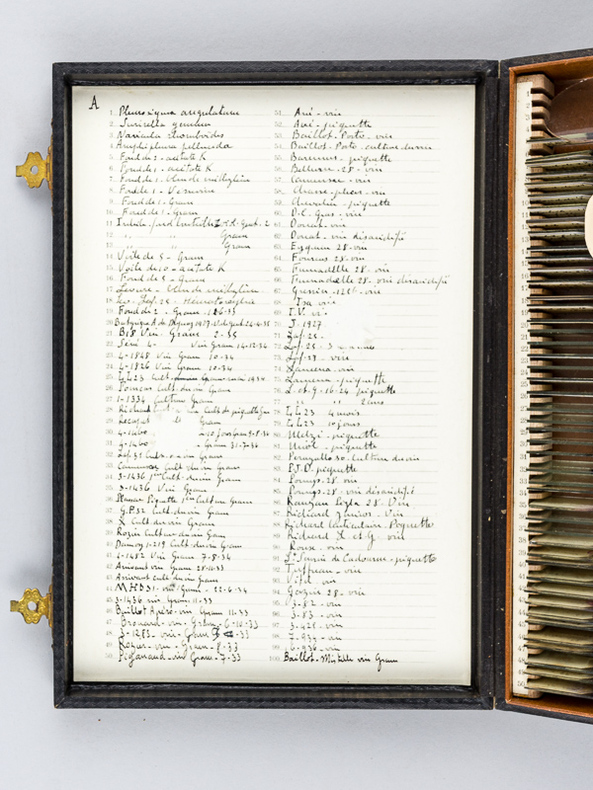
|
|
|
BOBIERRE, Adolphe [ BOBIERRE, Pierre Adolphe (1823-1881)
Leçons élémentaires de chimie appliquée aux arts, à l'industrie, à l'agriculture, à l'hygiène et à l'économie domestique, professées à la Chaire Municipale de Nantes. Ouvrage utile aux gens du monde, aux établissements d'instruction secondaire, et renfermant les connaissances comprises dans le programme du baccalauréat ès-lettres [ édition originale ]
1 vol. in-12 rel. demi-basane fauve, Victor Masson, libraire, Paris, 1852, 474 pp. + table + 2 pl. dépliantes en fin
Referencia librero : 53014

|
|
|
Collectif
Hommage à René Dujarric de La Rivière 19 avril 1985. Président de l'Institut de France, Président de l'Académie des Sciences [ Ouvrage édité à l'occasion du Centenaire de sa naissance, organisé par la ville d'Excideuil ]
1 vol. in-8 br., Imprimerie de l'Eperon, 1985, 112 pp.
Referencia librero : 53136

|
|
|
THENARD, Louis Jacques
Traité de Chimie élémentaire, théorique et pratique (4 Tomes - Complet)
Seconde édition, revue et corrigée, 4 vol. in-8 reliure de l'époque pleine basane racinée, Chez Crochard, Paris, 1817-1818, xvi-648 pp. ; xvi-712 pp. ; xvi-715 pp. ; x pp., 1 f., 392 pp. et 34 planches hors texte (bien complet de la planche 7 bis) avec une planche dépliante, et un tableau dépliant
Referencia librero : 54256

|
|
|
MACKENZIE, Colin
Mémorial pratique du Chimiste-Manufacturier, ou Recueil de procédés d'Arts et de Manufactures (3 Tomes - Complet) [ Edition originale de la traduction ]
Traduit de l'anglais sur la troisième édition de l'ouvrage de M. Colin Mackenzie, intitulé One thousand experiments in Chemistry, revu et considérablement augmenté par le traducteur, 3 vol. in-8 reliure demi-percaline marron, Chez Barrois l'Aîné, Paris, 1824, xxxiv-456 pp. avec 3 planches dépliantes ; 2 ff., 468 pp. ; 2 ff., 492 pp.
Referencia librero : 54257

|
|
|
Collectif ; Comité International de la Rayonne et des Fibres Synthétiques
Rayonne et Acétate - Fibranne [ Avec : ] Rayonne - Acétate - Fibranne et textiles Synthétiques [ bien complet des 48 échantillons ]
2 vol. in-8 reliure éditeur demi-toile verte, Edition Synergie, Paris, s.d. [ circa 1950-1960 ], 32 pp. et 4 ff. avec 48 échantillons de tissus
Referencia librero : 54846

|
|
|
GAUDEFROY, Christophe
Thèses présentées à la Faculté des Sciences de Paris pour obtenir le grade de Docteur ès Sciences Physiques. 1re Thèse : Etude des figures de déshydratation à la surface des cristaux ; 2e Thèse : Propositions données par la Faculté. Soutenues le décembre 1919 [ Edition originale - Livre dédicacé par l'auteur ]
1 vol. in-8 br., Gauthier-Villars et Cie, Paris, 1919, 106 pp.Rappel du titre complet : Thèses présentées à la Faculté des Sciences de Paris pour obtenir le grade de Docteur ès Sciences Physiques. 1re Thèse : Etude des figures de déshydratation à la surface des cristaux ; 2e Thèse : Propositions données par la Faculté. Soutenues le décembre 1919 [ Edition originale - Livre dédicacé par l'auteur ]
Referencia librero : 55271

|
|
|
MONTMAHOU, E. de ; (CARRENO, D. Leonardo)
Manual medico-legal de Venenos
Precedido de consideraciones sobre el envenenamientos ; de los medios de probarlo ; del resultando de esperiencias hechas sobre et acetato de morfina [ ... ] Escrito en frances à la vista del profesor Chaussier por E. de Montmahou, traducido al Castellano por D. Leonardo Carreno, adornado con veinte lamnias iluminadas, 1 vol. in-12 reliure espagnol de l'époque, Imprenta de Don Pedro Sanz, Madrid, Agosto, 1833, 236 pp., 7 ff. n. ch. et 20 figures en 10 planches dépliantes
Referencia librero : 57050

|
|
|
LAPORTE, Guy-Sylvain
"Au chevet de Lascaux..." Les travaux de la Commission Scientifique pour la sauvegarde des peintures rupestres de la grotte préhistorique.
Conférence donnée dans le cadre de la Commission Pharmaceutique franco-britannique les 16, 17 et 18 novembre, 1 brochure in-8, Extrait du Bulletin de l'Ordre des Pharmaciens n° 143, s.d. [ 1971 ], 39 pp.
Referencia librero : 57079

|
|
|
GAYON, Ulysse ; BLAREZ, Ch. ; DUBOURG, F.
Analyse chimique des Vins Rouges du Département de la Gironde, Récolte de 1887 [ Avec : ] Analyse chimique des Vins du Département de la Gironde, Vins rouge de la Récolte de 1888 et Vins blancs de la récolte de 1887 [ Avec : ] Les Vins de Bordeaux au point de vue chimique, 1895 [ Avec : ] Analyse chimique des Vins de la Gironde. Récolte de 1911
4 brochures in-8, Analyse chimique des Vins Rouges du Département de la Gironde, Récolte de 1887, G. Masson, Féret et Fils, Bordeaux, 1888, 47 pp. [ Avec : ] Analyse chimique des Vins du Département de la Gironde, Vins rouge de la Récolte de 1888 et Vins blancs de la récolte de 1887, Imprimerie Nationale, extrait du Bulletin de l'Agriculture, 1889, 24 pp. [ Avec : ] Les Vins de Bordeaux au point de vue chimique, par le Dr. Ch. Blarez, Imprimerie G. Gounouilhou, Bordeaux, 1895, 21 pp. [ Avec : ] Analyse chimique des Vins de la Gironde, par E. Dubourg, Récolte de 1911, Extrait des Annales des Falsifications, Juin 1912, avec envoi de l'auteur, pp. 281-296
Referencia librero : 57784
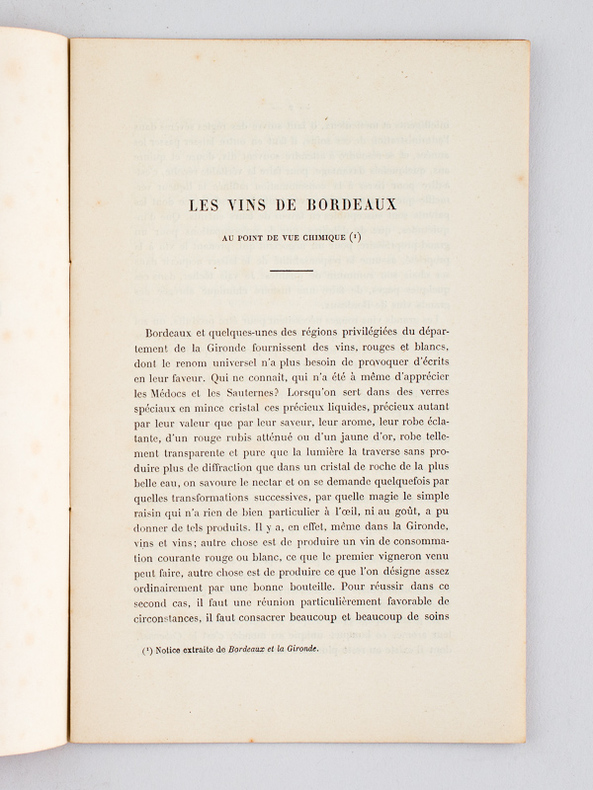
|
|
|
JAKSCH, Docteur Rudolf V. ; (MOULE, L.) ; [ VON JAKSCH, Dr. Rudolf ]
Manuel de diagnostic des Maladies internes par les Méthodes bactériologiques, chimiques et microscopiques [ Edition originale de la traduction française ]
Traduit de l'allemand par L. Moulé, ouvrage orné de 108 gravures en noir et en couleurs, 1 vol. grand in-8 reliure de l'époque demi-chagrin à coins brun, dos à 5 nerfs orné, filets dorés en mors et coins, Georges Carré, Paris, 1888, XIX-354 pp.
Referencia librero : 57823

|
|
|
SAINT-LAURENT, Pierre ; ST-LAURENT, Pierre
Etudes théoriques des réactions monomoléculaires en phase gazeuse. Thèse présentée à l'Ecole des Gradués de l'Université Laval pour l'obtention du grade de Docteur ès Sciences.
1 vol. in-4 reliure demi cuir, dos à 4 nerfs dorés, Faculté des Sciences, Laval (Québec), Octobre 1969, XVIII-131 pp.
Referencia librero : 58352
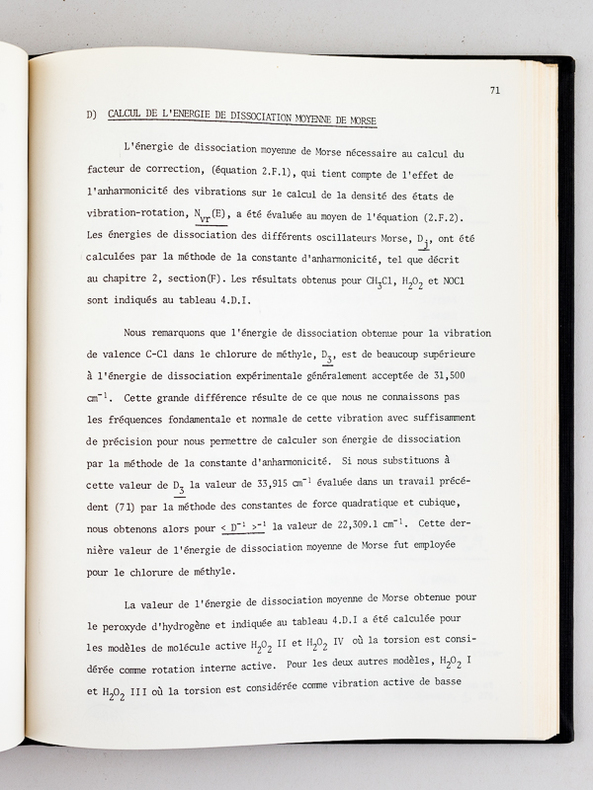
|
|
|
PAQUIN, Yves
Etude de la décomposition thermique de l'Azométhane. Thèse présentée à l'Ecole des Gradués de l'Université Laval pour l'obtention du grade de Docteur ès Sciences.
Travail effectué au Département de Chimie de l'Université Laval sous la direction du Professeur Wendell Forst, 1 vol. in-4 reliure demi cuir, dos à 4 nerfs dorés, Faculté des Sciences, Université Laval (Québec), Août 1971, 200 pp.
Referencia librero : 58353
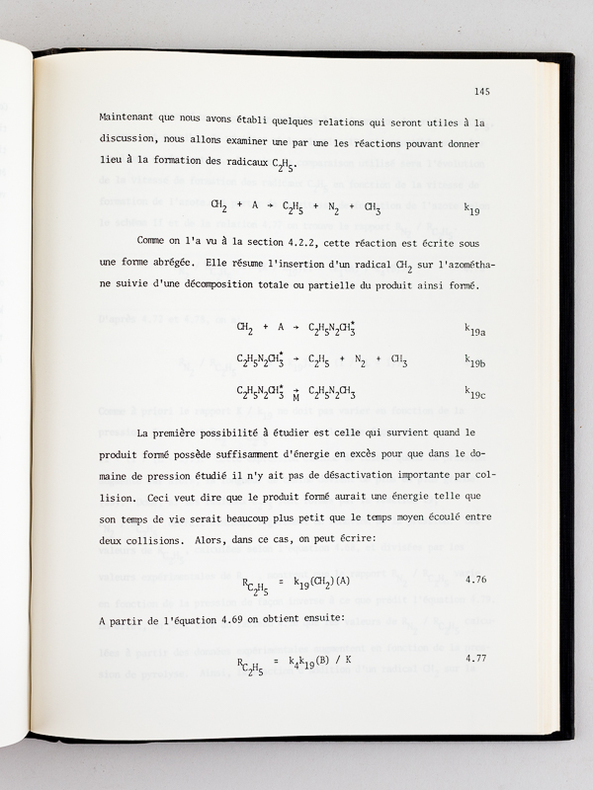
|
|
|
TESSIER, André
Etude de la décomposition homogène en phase gazeuse du péroxyde d'hydrogène par spectrométrie de masse quadrupolaire en utilisant l'échantillonnage par faisceau moléculaire. Thèse présentée à l'Ecole des Gradués de l'Université Laval pour l'obtention du grade de Docteur ès Sciences.
1 vol. in-4 reliure demi cuir, dos à 4 nerfs dorés, Faculté des Sciences, Université Laval (Québec), février 1970, XV-254 pp.
Referencia librero : 58354
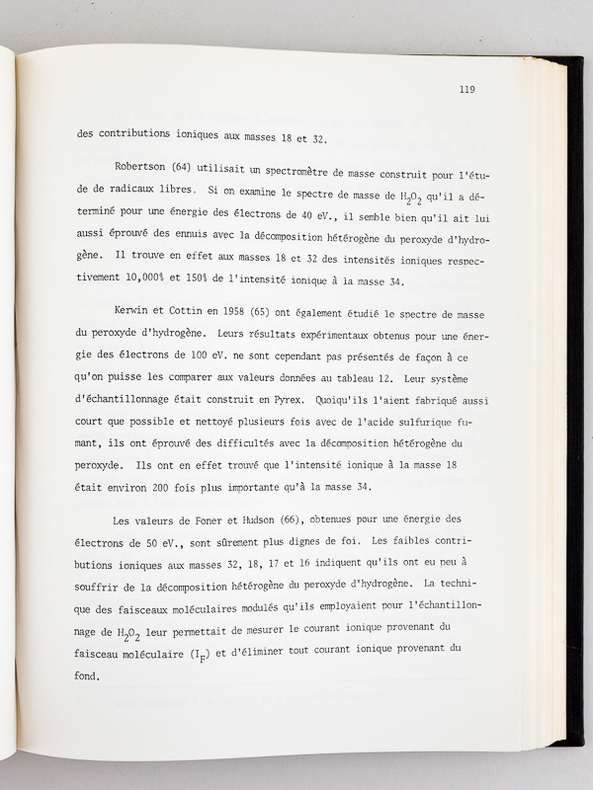
|
|
|
DESCAMPS, Bernard
Etude de la décomposition thermique du perfluorodimethyl peroxyde. Thèse présentée à l'Ecole des Gradués de l'Université Laval pour l'obtention du grade de Docteur ès Sciences.
1 vol. in-4 reliure demi cuir, dos à 4 nerfs dorés, Faculté des Sciences, Université Laval (Québec), mars 1972, 120 pp.
Referencia librero : 58355
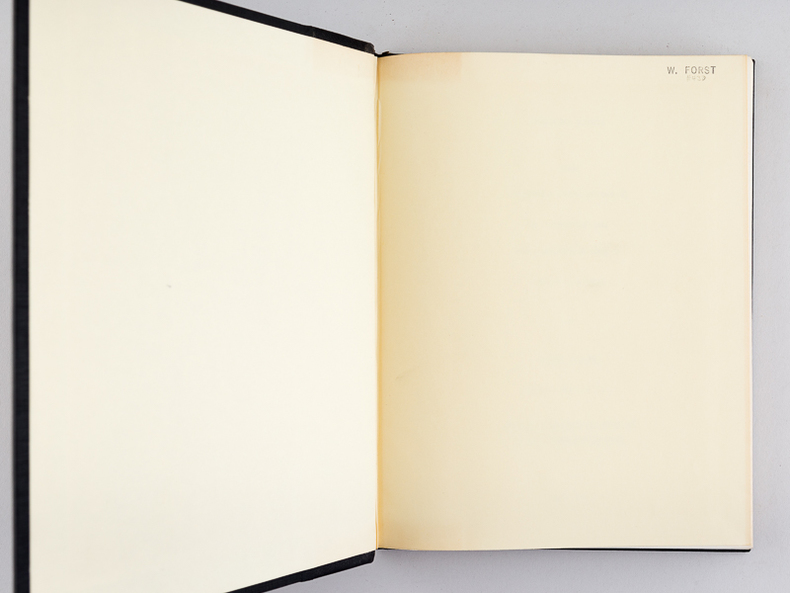
|
|
|
PAVADAY, Harold E.
Etude de la Réaction d'Atomes de Fluor avec des Fluorocarbures dans un système à écoulement rapide. Thèse présentée à l'Ecole des Gradués de l'Université Laval pour l'obtention du grade de Philosophiae Doctor
1 vol. in-4 cartonnage bradel, Faculté des Sciences, Université Laval (Québec), Avril 1982, 226 pp.
Referencia librero : 58356
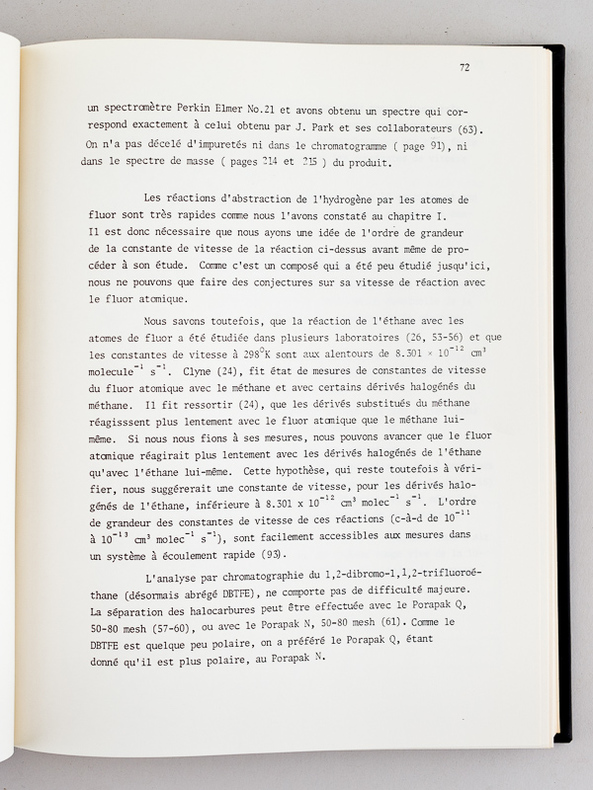
|
|
|
SCHOENENBERGER, Christian
Réactions monomoléculaires thermiques par inversions numériques de la transformée de Laplace : Application à N2O. Thèse présentée à l'Ecole des Gradués de l'Université Laval pour l'obtention du grade de Maître ès Sciences
1 vol. in-4 cartonnage bradel, Faculté des Sciences, Université Laval (Québec), Octobre 1983, X-127 pp. pp.
Referencia librero : 58357
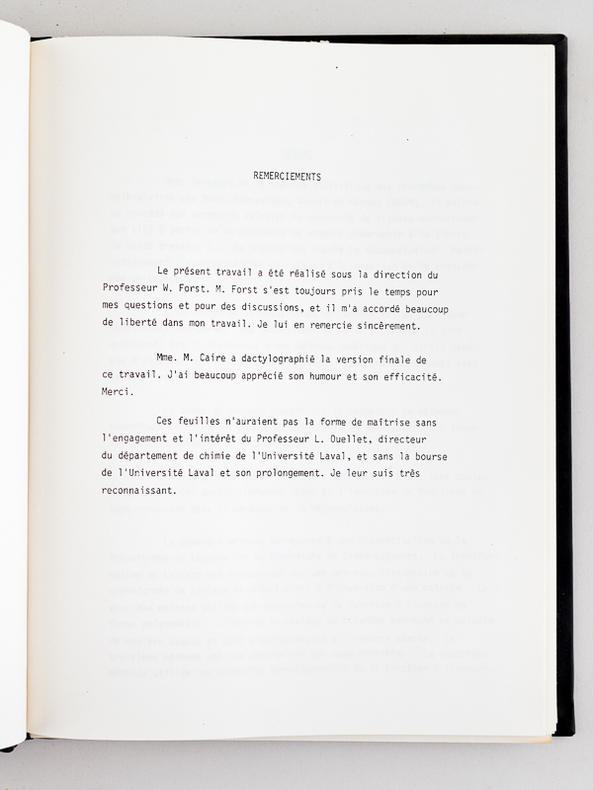
|
|
|
GIDIOTIS, Grigorios
Théorie de transfert d'énergie par collisions. Représentations de l'Equation maîtresse en termes de moments. Thèse présentée à l'Ecole des Gradués de l'Université Laval pour l'obtention du grade de Philosophiae Doctor. [ on joint :] Théorie de transfert d'énergie par collision. Thèse présentée à l'Ecole des Gradués de l'Université Laval pour l'Obtention du Grade de Maître ès Sciences (M. Sc.)
2 vol. in-4 cartonnage bradel, Décembre 1985, 164 pp. et Août 1983, XVIII-202 pp.Rappel du titre complet : Théorie de transfert d'énergie par collisions. Représentations de l'Equation maîtresse en termes de moments. Thèse présentée à l'Ecole des Gradués de l'Université Laval pour l'obtention du grade de Philosophiae Doctor. [ on joint :] Théorie de transfert d'énergie par collision. Thèse présentée à l'Ecole des Gradués de l'Université Laval pour l'Obtention du Grade de Maître ès Sciences (M. Sc.)
Referencia librero : 58358
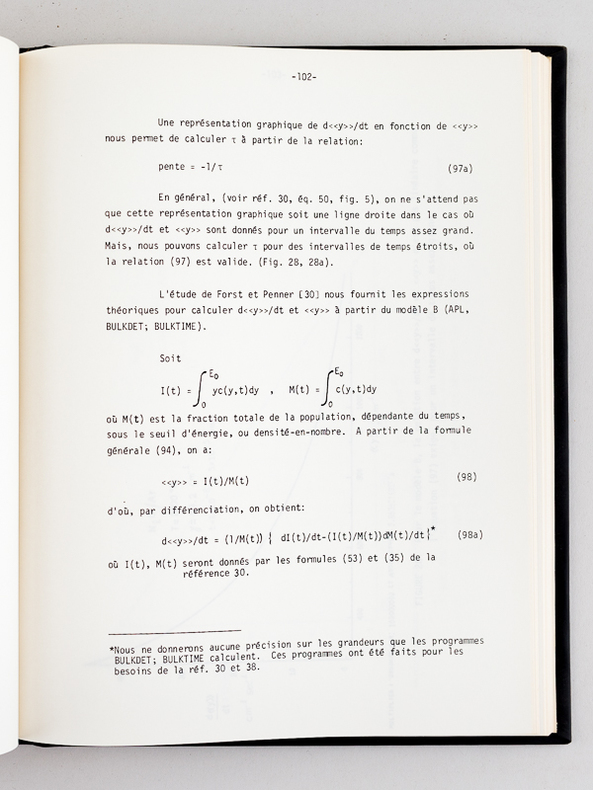
|
|
|
LE-KHAC HUY
Etude théorique de la Substitution électrophile des polymethylnaphtalènes par la théorie des orbitales moléculaires. Thèse présentée à l'Ecole des Gradués de l'Université Laval pour l'obtention du grade de Docteur ès Sciences [ on joint :] Etudes théoriques de la décomposition monomoléculaire des Radicaux monochloroethyle chimiquement actives. Thèse présentée à l'Ecole des Gradués de l'Université Laval pour l'obtention du grade de Maître ès Sciences.
2 vol. in-4 reliure demi cuir, dos à 4 nerfs dorés, Juillet 1970, XIV-221 pp.et Septembre 1968, IX-65 pp.Rappel du titre complet : Etude théorique de la Substitution électrophile des polymethylnaphtalènes par la théorie des orbitales moléculaires. Thèse présentée à l'Ecole des Gradués de l'Université Laval pour l'obtention du grade de Docteur ès Sciences [ on joint :] Etudes théoriques de la décomposition monomoléculaire des Radicaux monochloroethyle chimiquement actives. Thèse présentée à l'Ecole des Gradués de l'Université Laval pour l'obtention du grade de Maître ès Sciences.
Referencia librero : 58359

|
|
|
FORST, Wendell
Reactions of methyl cyanide with hydrogen atoms and with active nitrogen. A thesis submitted to the Faculty of Graduate Studies and Research of McGill University in partial fuflfillment of the requirements for the degree of Doctor of Philosophy
From the Physical Chemistry Laboratory under the supervision of Dr. C. A. Winkler, 1 vol. in-4 reliure demi cuir, dos à 4 nerfs dorés, McGill University, Montréal, June 1955, 192 pp.
Referencia librero : 58360
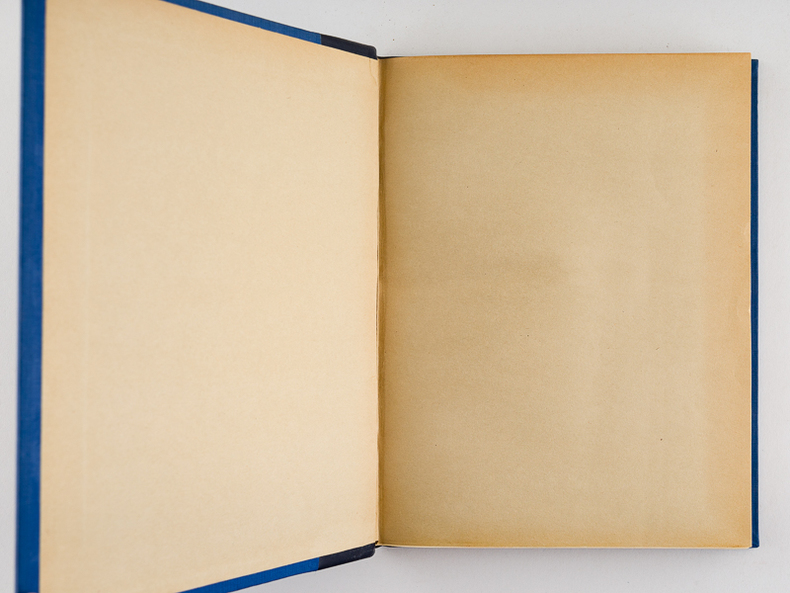
|
|
|
LIPPENS-GIGUERE, Magdeleine
Monsieur Peroxyde. Biographie du chimiste canadien Paul-Antoine Giguère, C.C. [ Edition originale ]
Tirage à 100 exemplaires, 1 vol. in-8 br., Magdeleine Lippens-Giguère, Québec, 1986, 325 pp.
Referencia librero : 58367

|
|
|
VOTOCEK, Dr. Emil
Chemie anorganicka
Napsal Emil Votocek, III Vydani, doplnene spolupraci Dr. Jaroslava Heyrovského, 1 vol. fort in-8 reliure demi-chagrin à coins noir, dos à 4 nerfs, Nakladem Ceske Chemicke Spolecnosti, V Praze, 1940, 999 pp.
Referencia librero : 58368

|
|
|
DE PARVILLE, Henri ; (BREWER ; MOIGNO )
La Clef de la Science. Explication des phénomènes de tous les Jours par Brewer et Moigno
Edition refondue et ornée de 250 gravures, 1 vol. grand in-8 reliure de l'époque plein veau bleu, toutes tranches dorées, plats aux armes d'Antoine Stillemans, évêque de Gand (avec sa devise "Vivat Jesus"), Librairie Renouard, Henri Laurens, Paris, 1892, VI-492 pp.
Referencia librero : 58429

|
|
|
CHEVALLIER, A.
Dictionnaire des Altérations et Falsifications des Substances alimentaires, médicamenteuses et commerciales avec l'indication des moyens de les reconnaître (2 Tomes - Complet)
Troisième édition revue, corrigée et augmentée, 2 vol. in-8 reliure demi-chagrin rouge, dos à 4 nerfs orné, Béchet Jeune, Paris, 1858, 2 ff., 767 pp. avec 7 planches hors texte ; VII-632 pp. avec 5 planches hors texte
Referencia librero : 58623

|
|
|